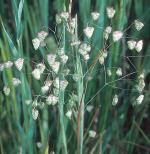Little Quaking Grass is a member of the grass family. Each grass flower is made up of a pair of tiny bracts, the stamens and pistil. The flowers are grouped into clusters called florets. Because grasses are wind-pollinated, they do not need showy flowers to attract insects. In fact, petals could block the wind and prevent pollination.
The rattle-like florets of this plant are distinctive and you are unlikely to confuse it with any other grass.
Scientific name: Briza minor
Family: Poaceae (grass)
Habitat: Grasslands (moist)
Size: Plant up to 6 inches tall; floret 3 to 4 mm across
Fun Facts:
The florets of this grass resemble the rattles on the tail of a rattlesnake.
Life Cycle:
Little Quaking Grass is an annual plant, so it dies off every year. It germinates over the winter and blooms in April and May.
Ecology:
Little Quaking Grass is not native in California. Usually non-native plants are considered weedy and bad for the ecosystem. However, this plant is not an aggressive weed and only occurs sparingly. These kinds of non-aggressive, non-native plants are sometimes called naturalized (meaning that they live here in harmony with the native species).
Investigate:
Each floret of Little Quaking Grass is made up of numerous individual flowers. Can you count the bracts and figure out how many flowers make a floret? Is every floret made up of the same number of flowers?
